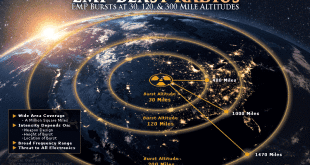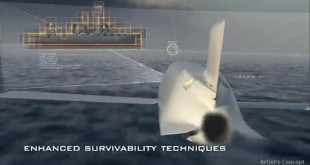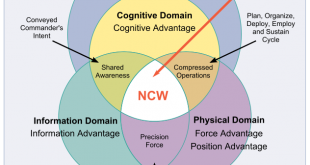The electromagnetic pulse commonly abbreviated as EMP, is a high-intensity burst of electromagnetic energy caused by the rapid acceleration of charged particles, can be produced by intense solar storms or by a nuclear weapon detonated high in the atmosphere. For example, solar geomagnetic storms (geomagnetic disturbances or GMD) create immediate …
Read More »Militaries developing underwater weapons from Amphibious guns to Supercavitating bullets for Underwater Warfare
Underwater warfare is one of the three operational areas of naval warfare, the others being surface warfare and aerial warfare. It refers to combat conducted underwater such as: Actions by submarines actions, and anti-submarine warfare, i.e. warfare between submarines, other submarines and surface ships; combat airplanes and helicopters may also …
Read More »Threat of AI enabled or Autonomous Nuclear weapons
AI is projected to create 11 trillion dollars of economic value in the next decade. This is driving vigorous AI race among countries led by US, China, Russia who are spending billions of dollars to assume leadership in its development and utilization for economic and military advantage. In Defense …
Read More »Nanomaterials for protection from laser weapons
Laser attacks targeting pilots and air crews are a major concern across the world with most attacks reported to take place during take-off and landing. According to figures from the US Federal Aviation Authority, there were 6,753 laser illuminations reported in 2017. Until recently, the expense of lasers had limited their use …
Read More »Military race to develop autonomous and intelligent missiles and missile swarms to strike targets in anti-access, area-denial environment
Artificial intelligence is a branch of computer science dealing with the simulation of intelligent behavior in computers. A computer system able to perform tasks that normally require human intelligence, such as visual perception, speech recognition, decision-making, and translation between languages. Machine learning is a subset of AI. AI has a …
Read More »DARPA MFP developed drone swarm interceptor system to protect convoys moving through populated regions
“The rapid evolution of small unmanned air systems (sUAS) technologies is fueling the exponential growth of the commercial drone sector, creating new asymmetric threats for warfighters. sUASs’ size and low cost enable novel concepts of employment that present challenges to current defense systems. These emerging irregular systems and concepts of …
Read More »Soft Recoil Technology
Artillery weapons have been used for hundreds of years. These weapons have been continuously developed to improve accuracy, effectiveness, and efficiency. When an artillery weapon is fired, the energy of the round must be absorbed by the weapon’s structure and eventually transmitted to the ground. The recoil system is …
Read More »Israeli arms industry uses Gaza strip as their testing laboratory for new weapons development and to sell them as battle proven weapons
An outbreak of violence in the ongoing Israeli–Palestinian conflict commenced on 10 May 2021, though disturbances took place earlier, and continued until a ceasefire came into effect on 21 May. It was marked by protests and rioting, police riot control, rocket attacks on Israel by Hamas and Palestinian Islamic Jihad, …
Read More »Countries developing Strategies and Tactics for warfighting for Information Warfare
A rapidly increasing percentage of the world’s population is connected to the global information environment. The new information age has seen rise of social media, bloggers, smartphones, plethora of cable and satellite news channels. It can also be seen in the ongoing Internet of things revolution, the internetworking of physical …
Read More »DARPA SocialSim developing effective Information warfare analysis tools for social media
A rapidly increasing percentage of the world’s population is connected to the global information environment. At the same time, the information environment is enabling social interactions that are radically changing how and at what rate information spreads. Both nation-states and nonstate actors have increasingly drawn upon this global information environment …
Read More » International Defense Security & Technology Your trusted Source for News, Research and Analysis
International Defense Security & Technology Your trusted Source for News, Research and Analysis









